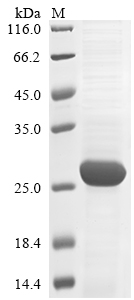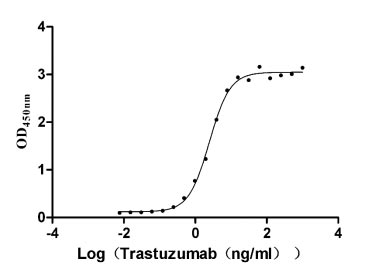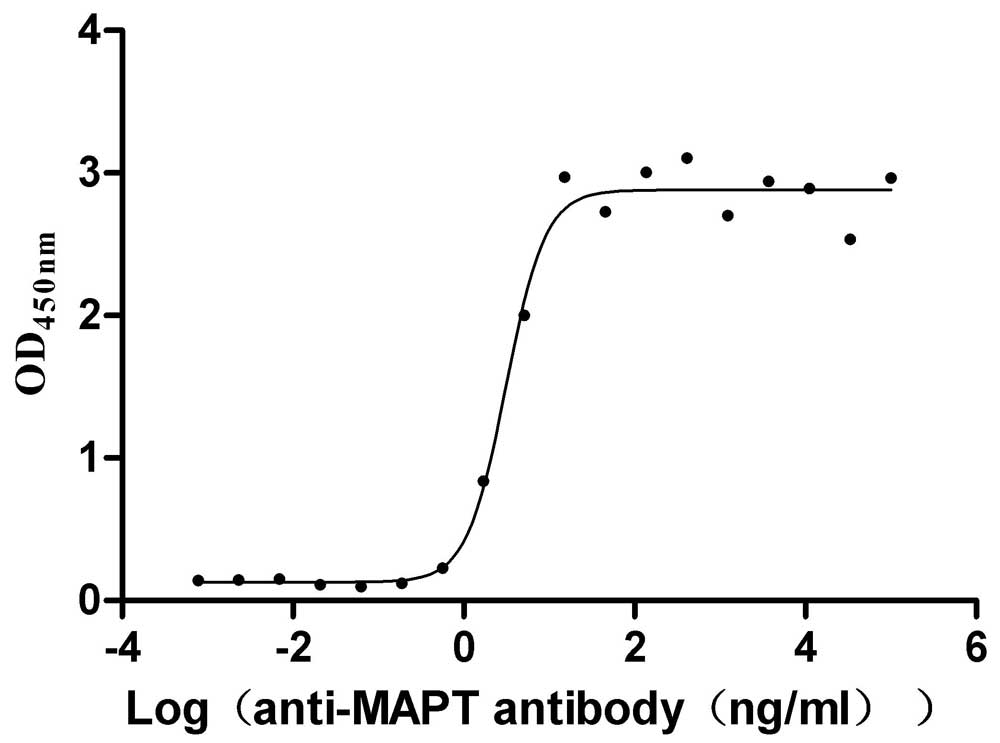Recombinant Human Retinoblastoma-like protein 2 (RBL2), partial
-
货号:CSB-EP600921HU
-
规格:¥1,836
-
图片:
-
其他:
产品详情
-
纯度:Greater than 85% as determined by SDS-PAGE.
-
基因名:
-
Uniprot No.:
-
种属:Homo sapiens (Human)
-
蛋白长度:Partial
-
来源:E.coli
-
分子量:27.4 kDa
-
表达区域:417-616aa
-
氨基酸序列TPVSTATHSLSRLHTMLTGLRNAPSEKLEQILRTCSRDPTQAIANRLKEMFEIYSQHFQPDEDFSNCAKEIASKHFRFAEMLYYKVLESVIEQEQKRLGDMDLSGILEQDAFHRSLLACCLEVVTFSYKPPGNFPFITEIFDVPLYHFYKVIEVFIRAEDGLCREVVKHLNQIEEQILDHLAWKPESPLWEKIRDNENRV
Note: The complete sequence including tag sequence, target protein sequence and linker sequence could be provided upon request. -
蛋白标签:N-terminal 6xHis-tagged
-
产品提供形式:Liquid or Lyophilized powder
Note: We will preferentially ship the format that we have in stock, however, if you have any special requirement for the format, please remark your requirement when placing the order, we will prepare according to your demand. -
缓冲液:If the delivery form is liquid, the default storage buffer is Tris/PBS-based buffer, 5%-50% glycerol. If the delivery form is lyophilized powder, the buffer before lyophilization is Tris/PBS-based buffer, 6% Trehalose.
-
复溶:We recommend that this vial be briefly centrifuged prior to opening to bring the contents to the bottom. Please reconstitute protein in deionized sterile water to a concentration of 0.1-1.0 mg/mL.We recommend to add 5-50% of glycerol (final concentration) and aliquot for long-term storage at -20℃/-80℃. Our default final concentration of glycerol is 50%. Customers could use it as reference.
-
储存条件:Store at -20°C/-80°C upon receipt, aliquoting is necessary for mutiple use. Avoid repeated freeze-thaw cycles.
-
保质期:The shelf life is related to many factors, storage state, buffer ingredients, storage temperature and the stability of the protein itself.
Generally, the shelf life of liquid form is 6 months at -20°C/-80°C. The shelf life of lyophilized form is 12 months at -20°C/-80°C. -
货期:Delivery time may differ from different purchasing way or location, please kindly consult your local distributors for specific delivery time.
-
注意事项:Repeated freezing and thawing is not recommended. Store working aliquots at 5°C for up to one week.
-
Datasheet & COA:Please contact us to get it.
相关产品
靶点详情
-
功能:Key regulator of entry into cell division. Directly involved in heterochromatin formation by maintaining overall chromatin structure and, in particular, that of constitutive heterochromatin by stabilizing histone methylation. Recruits and targets histone methyltransferases KMT5B and KMT5C, leading to epigenetic transcriptional repression. Controls histone H4 'Lys-20' trimethylation. Probably acts as a transcription repressor by recruiting chromatin-modifying enzymes to promoters. Potent inhibitor of E2F-mediated trans-activation, associates preferentially with E2F5. Binds to cyclins A and E. Binds to and may be involved in the transforming capacity of the adenovirus E1A protein. May act as a tumor suppressor.
-
基因功能参考文献:
- Three fold reduced Rbl2/p130 expression in these tumor tissues were noticed compared to their control tissues. DNA obtained from MNAse digested chromatin was used as PCR template. PMID: 29417345
- Hepatitis C virus core protein modulates pRb2/p130 expression in human hepatocellular carcinoma cell lines through promoter methylation PMID: 26576645
- Statistical analysis revealed that Rbl2/p130 expression negatively correlates to its promoter methylation (r = -0.412) in tumor tissues. PMID: 26271034
- TGF-beta induced RBL2 expression through down-regulating miR-93 in renal cancer cells PMID: 25183046
- expression profiling of miRNAs in high-grade serous ovarian carcinoma indicated miR-106a and its family members were upregulated; findings suggest miR-106a can repress expression of the retinoblastoma family member RBL2 and miR-106a overexpression results in rapid tumor growth and poor differentiation PMID: 24045973
- Low expression of RBL2 is associated with glioma. PMID: 23377830
- Our hypothesis not only enrich the knowledge of the regulation of ALT, but also indicate that p130 may serve as a potential suppressor of ALT, and gene therapy of p130 may be used in cervical cancers. PMID: 22595804
- The results show that continued human papillomavirus 16 E6/E7 expression is necessary in cervical cancer cells to prevent cell-cycle arrest by a repressive p130-DREAM complex. PMID: 21813705
- Hypoproliferation and loss of differentiation in organotypic raft cultures of primary neonatal human foreskin keratinocytes depleted of the alpha and beta isoforms of p63 result from p53-p21-mediated accumulation of retinoblastoma (Rb) family member p130. PMID: 21511729
- The activity of CTCF in controlling Rb2/p130 gene expression is impaired by BORIS, which by binding to the Rb2/p130 gene could trigger changes in the chromatin asset established by CTCF affecting CTCF regulatory activity on Rb2/p130 transcription. PMID: 21325284
- Human papillomavirus E7 protein K39,42R mutation moderately increased the association with and the destabilization of p130. PMID: 21411531
- Gsk3beta, p130 and beta-catenin form in MSC a complex the functional role of which may be associated with activation of differentiation not coupled to cell cycle arrest. PMID: 21516817
- heterogeneous RB (pRb2 or p16) and p53 (p53, p14, or p21) pathway alterations occur frequently in Burkitt lymphoma PMID: 21127431
- Loss of p130 accelerates tumor development in a mouse model for human small-cell lung carcinoma. PMID: 20406986
- FTO influence RBL2 gene expression at large genetic distances PMID: 20009087
- Data suggest that KSHV miRNA targets multiple pathways to maintain KHSV latency, including repression of the viral protein Rta and a cellular factor, Rbl2, and increased cellular DNMT, in regulating global epigenetic reprogramming. PMID: 20071580
- The half-life of p130, relative to control cells, was decreased in the cytoplasm in the presence of human papillomavirus 6 E7 or human papillomavirus 16 E7, but only decreased by HPV 6 E7 in the nucleus. PMID: 20189212
- p130 and its truncated form might substitute Rb in mediating p53-induced cell cycle arrest in Rb(-/-) Saos2 cells PMID: 12386819
- p130 turnover is regulated by Cdk-dependent G1 phosphorylation leading to ubiquitin-dependent proteolysis PMID: 12435635
- Expression of this gene predicts outcome in squamous cell carcinoma of the esophagus. PMID: 12474056
- reduced p130 expression may contribute to the aggressive character of anplastic carcinoma; and p130 may specify the growth characteristics of microcarcinoma PMID: 12637156
- We investigated occupancy of ER-alpha promoter by pRb2/p130-E2F4/5-HDAC1-SUV39 H1-p300 and pRb2/p130-E2F4/5-HDAC1-SUV39H1-DNMT1 complexes, and provided a link between pRb2/p130 and chromatin-modifying enzymes in the regulation of ER-alpha transcription PMID: 12789259
- Analysis of gene expression level profiles showed that parental cell line undergoes apoptosis through an E2F1/p73-dependent pathway while its drug resistant variant evades it. PMID: 12789260
- ATRA mediates growth inhibition by stabilizing Rb2/p130 via a mechanism that involves induction of PP2A, an enzyme that can potentially dephosphorylate Rb2/p130, thereby protecting it from degradation by the proteasome. PMID: 12915404
- T Ag recruits a phosphatase activity in a DNA J domain-dependent manner to reduce the phosphorylation of p130 PMID: 12968030
- The interaction between HIV-1 tat and Rb2 may be a possible mechanism in the pathogenesis of AIDS-related lymphoma. PMID: 13679860
- Rb2/P130 target genes in non-small-cell lung neoplasms are identified by microarray analysis. PMID: 14534545
- Reduced transcription of the RB2/p130 gene is associated with lung cancer PMID: 14587097
- pRb2/p130 has a role as a tumour suppressor protein in hepatocellular carcinoma PMID: 15059924
- pRb2/p130 overexpression is able to arrest cell growth in ovarian carcinoma cells, suggesting the putative role of pRb2/p130 as a tumor suppressor in this malignancy. PMID: 15131049
- VEGF together with pRb2/p130 may have a role in hepatocellular carcinoma in a p27((KIP1))-independent manner PMID: 15161709
- Disruption of E2F4 through small interfering RNA prevented p130/E2F4 complex formation and sensitized prostate cancer cells to IR-induced apoptosis. PMID: 15231644
- Rb2/ p130 expression can additionally be an indicator of a better prognosis in patients with gliomas PMID: 15696973
- RBP2 resembles other chromatin-associated transcriptional regulators and RBP2 binding to activate transcription and promote differentiation. PMID: 15949438
- p130 is a trancriptional regulator of the cell cycle genes. PMID: 16135806
- Involved in progression and regulation of telomerase PMID: 16364039
- ER-beta and pRb2/p130 proteins co-immunoprecipitate in both nucleus and cytoplasm of MCF-7 breast cancer cells. The interaction of pRb2/130 with ER-beta may have a functional significance in regulating ER-beta activity. PMID: 16760287
- All-trans-retinoic acid (ATRA) has been shown to arrest the growth of ovarian carcinoma cells in G0/G1 and to significantly elevate levels of Rb2/p130 protein. (review) PMID: 16936753
- supportive role in the genesis of retinoblastoma has recently been proposed for the RB1-related gene RB2/p130. (review) PMID: 16936755
- Mutated RBL2 is associated with Burkitt lymphoma PMID: 17485552
- Evolutionarily conserved multisubunit protein complex that contains p130 and E2F4 mediates the repression of cell cycle-dependent genes in quiescence. PMID: 17531812
- no mutation of p53 and RB2/p130 genes was identified in any of the blood samples from Malaysian nasopharyngeal carcinoma PMID: 17694957
- There was a strong correlation between the expression of p130 in Stage 1 & 3, but not Stage 2, tumors. High levels of p130 were detected in the cytoplasm rather than the nucleus, suggesting an aberrant subcellular localization of this tumor suppressor. PMID: 17905135
- Collectively, these data support the notion that p130 controls the homeostasis of the differentiated keratinocytes and is therefore targeted by E7 for degradation to establish conditions permissive for viral DNA amplification. PMID: 18321970
- P130 may be required to prevent the onset of terminal growth arrest in unstimulated prostate cancer cells lacking a functional Rb allele. PMID: 18418057
- It is possible that a hyperphosphorylated form of Rb2/p130 may contribute to the resistance of ovarian carcinoma cells to ATRA mediated growth suppression PMID: 18446820
- pRb2/p130 has a role in reducing survival in human soft tissue sarcomas PMID: 18676747
- Loss of heterozygosity within RBL2/p130 gene is associated with retinoblastoma. PMID: 19252413
- pRb2/p130 was mainly localized in the cytoplasm rather than in the nucleus in rectal cancer. PMID: 19597825
- Data suggest that Rb2/p130 is a member of the p53-p21 DNA damage signaling cascade, and represents the essential pocket protein family member needed for the induction of any type of senescence. PMID: 19648966
显示更多
收起更多
-
亚细胞定位:Nucleus.
-
蛋白家族:Retinoblastoma protein (RB) family
-
数据库链接:
HGNC: 9894
OMIM: 180203
KEGG: hsa:5934
STRING: 9606.ENSP00000262133
UniGene: Hs.513609
Most popular with customers
-
Recombinant Human Receptor tyrosine-protein kinase erbB-2 (ERBB2), partial (Active)
Express system: Mammalian cell
Species: Homo sapiens (Human)
-
Recombinant Macaca mulatta Microtubule-associated protein tau (MAPT) (Active)
Express system: Mammalian cell
Species: Macaca mulatta (Rhesus macaque)
-
Recombinant Human C-X-C chemokine receptor type 4 (CXCR4)-VLPs (Active)
Express system: Mammalian cell
Species: Homo sapiens (Human)
-
Recombinant Macaca fascicularis Trophoblast glycoprotein (TPBG), partial (Active)
Express system: Mammalian cell
Species: Macaca fascicularis (Crab-eating macaque) (Cynomolgus monkey)
-
Recombinant Human C-C chemokine receptor type 8 (CCR8)-VLPs (Active)
Express system: Mammalian cell
Species: Homo sapiens (Human)
-
Recombinant Human Desmoglein-2 (DSG2), partial (Active)
Express system: Mammalian cell
Species: Homo sapiens (Human)
-
Recombinant Human Cadherin-17 (CDH17), partial (Active)
Express system: Mammalian cell
Species: Homo sapiens (Human)
-
Recombinant Human CUB domain-containing protein 1 (CDCP1), partial (Active)
Express system: Mammalian cell
Species: Homo sapiens (Human)





-AC1.jpg)















